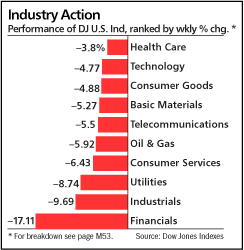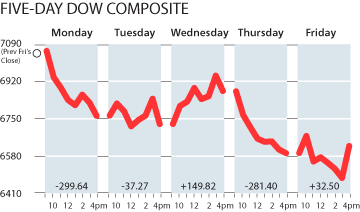From Barrons
Stocks fell 12 of the past 15 sessions. It might have been 13 if stocks hadn't mustered a sharp swerve higher late Friday afternoon, after the government reported 651,000 workers laid off in February. Total job cuts this recession reached 4.4 million as the unemployment rate climbed to 8.1%, worsening worries about rising loan defaults and more bank losses.
Such sharp selling, however, increases the odds of at least a temporary bounce in the oversold market, even if a lasting rally and economic rejuvenation remain elusive. Bear-market bounces are transient but are nothing to scoff at. The last one, from Nov. 20 to Jan. 6, produced a 24% gain. So even as stocks finished Friday near their lowest level since 1996, traders dutifully covered their short positions.
A LITTLE BOUNCE IS EASY, BUT AN enduring new bull market is tougher to spawn. Retailers, thanks to discounters like Wal-Mart (ticker: WMT), last month saw their first sales uptick since September. But twice-bitten, thrice-shy investors want to see a likely end to the blight in housing, banks and consumer spending before they commit again. Just last week, Wells Fargo (WFC) cut its dividends 85% to hoard capital, while General Motors (GM) reported a 53% drop in February sales.
Financial stocks fell hardest last week and could continue to flail as shareholders worry about encroaching government ownership. But that's not all, as fears percolate of a destabilizing international banking crisis. Unlike their U.S. counterparts, European banks grappling with flubbed loans to Eastern Europe are slow to book losses and raise capital. So far, the U.S. accounts for three-quarters of bank losses recognized globally, and doubts linger about the balance sheets of European banks.
"While the U.S. has the resources to bail out its financial institutions, the same may not be said for many other governments," says Jonathan Golub, a former Bear Stearns strategist who now runs his own firm, Golub Market Insights. Belgium's short-term bank liabilities are roughly 285% of its gross domestic product, while the figure is 260% for Switzerland, 156% for Great Britain and 60% for France and Germany -- versus 15% for the U.S.
Coaxing Americans to spend more also presents both a challenge and a conundrum. Americans had 20 cents of debt for every dollar of income in 1945, but that figure has since swelled to $1.20. During this span, "risky assets" like real estate, stock holdings and pension reserves had increased from 1.4 times the annual income to 4.7 times in 2007. To Jeff Lick, who manages Galt Investments, the U.S. has morphed from an "income earning culture" to one driven by asset appreciation. And in recent years, that growth "was a self-reinforcing positive feedback loop fueled by very high level consumption."
Now that household wealth has been cut swiftly and severely, a negative feedback loop has begun that could take years to play out. "The reality is so much of U.S. household consumption and GDP growth over the last five years was stuff we simply didn't need or simply won't miss," Lick says. He expects Americans to save more, and thinks the outlook for consumption growth is bleak.
That helps explain why government stimuli haven't quite managed to inspire the stock market. "Policy responses to this crisis are worrisome, especially U.S. actions aimed at supporting excess consumption and Chinese stimulus focused on sustaining excess investment," argues Stephen Roach, chairman of Morgan Stanley Asia.
Too Little, Too Late: A 146-point bounce late Friday cut the Dow Jones Industrial Average's loss last week to 6.2%. But it remains at its lowest level since 1997.
He thinks the U.S. needs to save instead and plow those savings toward infrastructure investment, alternative energy technology and human capital, while China needs to increase domestic consumption. Fighting this inevitable rebalancing will merely return us "to the very same strain of unbalanced economic growth that got us into this mess in the first place."
Subscribe to:
Post Comments (Atom)



No comments:
Post a Comment